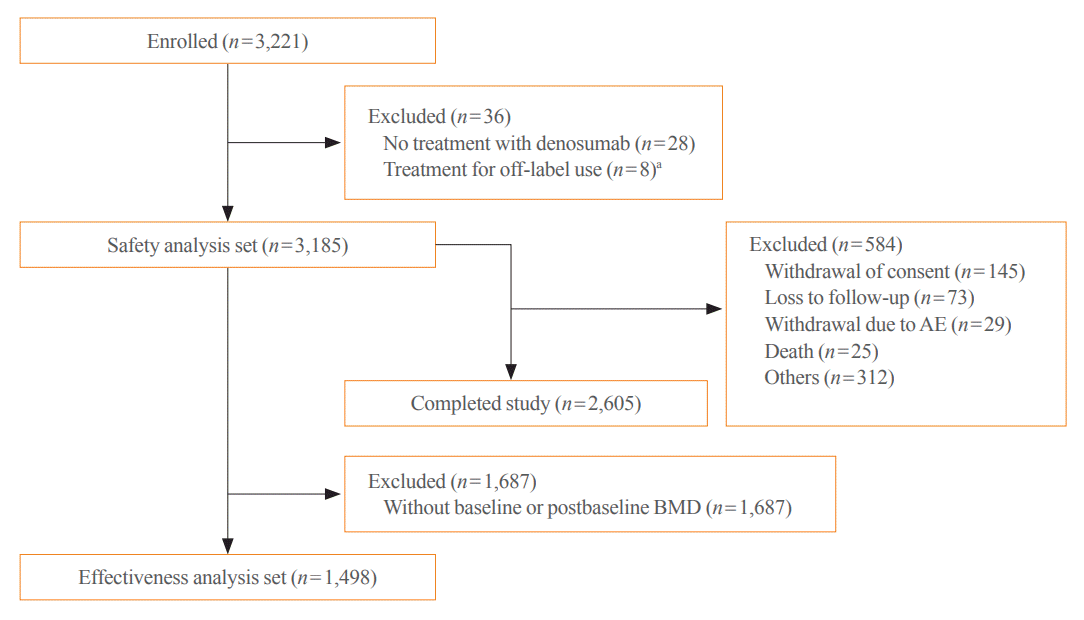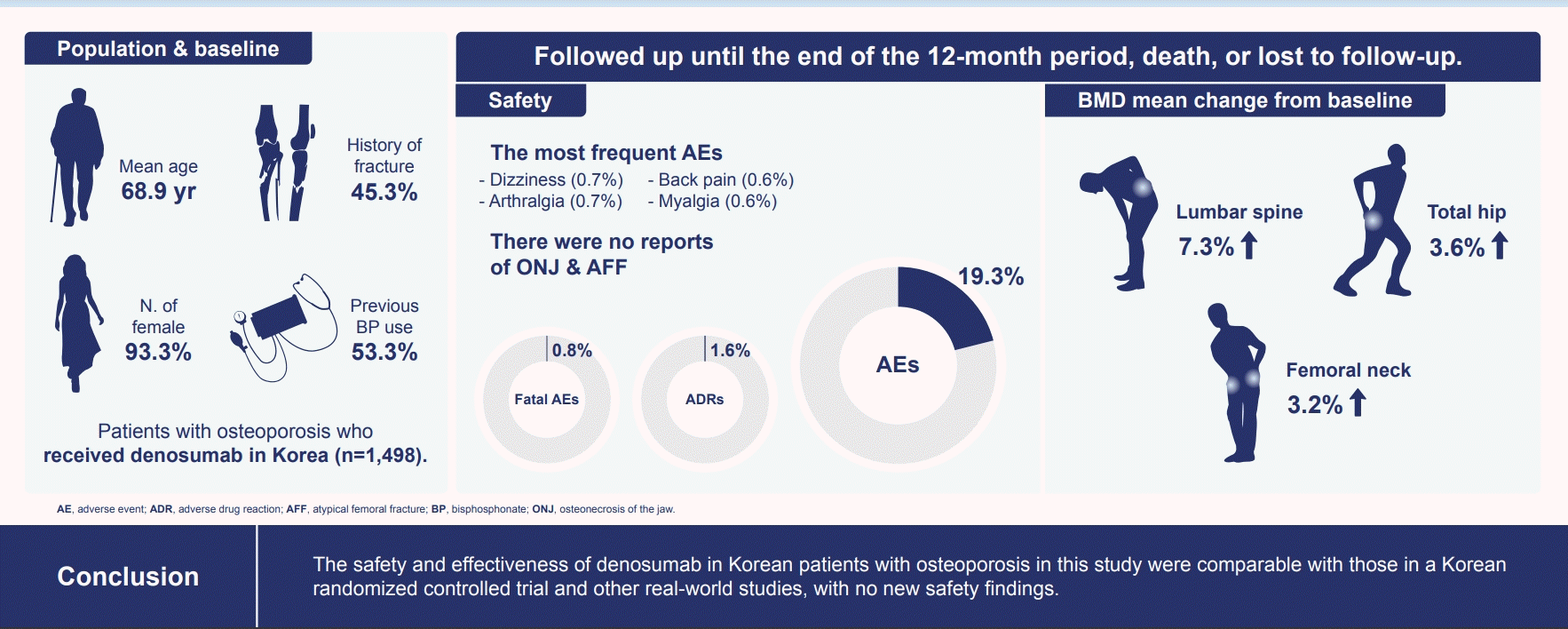INTRODUCTION
METHODS
Study objectives
Study design
Patients
Treatment
Assessments
Statistical analysis
RESULTS
Patient disposition
 | Fig. 1.Patient disposition. AE, adverse event; BMD, bone mineral density. aFour of eight patients treated with off-label denosumab were identified after three injections and included among those who completed the study; however, these patients were excluded from the safety analysis set and effectiveness analysis set. The dosing interval of the four patients was not based on the locally approved dosage; two patients had a 10-month interval, one had a 3-month interval, and one received two injections on the same day. |
Demographics and baseline clinical characteristics
Table 1.
| Variable | Safety analysis set (n=3,185) |
|---|---|
| Sex | |
| Female | 2,973 (93.3) |
| Male | 212 (6.7) |
| Age, yr | 68.9±9.9 |
| <65 | 1,120 (35.2) |
| 65–74 | 1,010 (31.7) |
| ≥75 | 1,055 (33.1) |
| BMI, kg/m2 | 22.5±3.3 |
| History of fracturea | 1,413 (45.3) |
| Prevalent vertebral fracture | 939 (30.1) |
| Prevalent hip fracture | 236 (7.6) |
| Prevalent other fracture | 454 (14.6) |
| Diagnosis | |
| Postmenopausal osteoporosis | 2,926 (91.9) |
| Male osteoporosis | 211 (6.6) |
| Bone loss due to AIT | 46 (1.4) |
| Bone loss due to ADTb | 2 (0.06) |
| Duration of osteoporosis, yr | |
| <1 | 874 (27.4) |
| ≥1 to <5 | 1,127 (35.4) |
| ≥5 to <10 | 661 (20.8) |
| ≥10 | 468 (14.7) |
| Unknown | 55 (1.7) |
| History of medication use for osteoporosisa | |
| Never usedc | 780 (25.0) |
| Prior use or current use | 2,288 (73.4) |
| Unknownd | 48 (1.5) |
| History of BP usea | |
| Not used | 1,277 (40.1) |
| Previously used | 1,699 (53.3) |
| Currently in use | 46 (1.4) |
| Unknown | 94 (3.0) |
| BMD T-scoree | |
| Lumbar spine | −2.8±0.97 |
| Total hip | −1.9±0.90 |
| Femoral neck | −2.4±0.87 |
Values are expressed as number (%) or mean±standard deviation.
BMI, body mass index; AIT, aromatase inhibitor therapy; ADT, androgen deprivation therapy; BP, bisphosphonate; BMD, bone mineral density.
Treatment exposure
Safety
AEs
Table 2.
| Variable |
Safety analysis set (n=3,185) |
|
|---|---|---|
| No. of patients (%) | No. of events | |
| AEs | 613 (19.3) | 1,057 |
| AEs leading to the discontinuation of denosumab | 36 (1.1) | 40 |
| SAEs | 227 (7.1) | 295 |
| Infections and infestationsa | 44 (1.4) | 49 |
| Neoplasmsb | 18 (0.6) | 19 |
| Cardiac disorders | 16 (0.5) | 18 |
| Fatal AEsc | 26 (0.8) | 26 |
| Most frequent AEs (>0.5%) | ||
| Dizziness | 22 (0.7) | 25 |
| Arthralgia | 21 (0.7) | 21 |
| Back pain | 20 (0.6) | 21 |
| Myalgia | 19 (0.6) | 19 |
| Pneumonia | 17 (0.5) | 17 |
| Headache | 16 (0.5) | 17 |
| AEs of special interest | ||
| Fracture | 40 (1.3) | 42 |
| Musculoskeletal pain | 28 (0.9) | 28 |
| Hypersensitivity | 20 (0.6) | 20 |
| Hypocalcemia | 10 (0.3) | 11 |
| Hyperparathyroidism tertiary | 1 (0.03) | 1 |
| Fracture nonunion (delayed healing) | 1 (0.03) | 1 |
| ADRs | 50 (1.6) | 62 |
| Most frequent ADRs | ||
| Myalgia | 10 (0.3) | 10 |
| Paind | 9 (0.3) | 9 |
| Hypocalcemia | 9 (0.3) | 10 |
| Serious ADRs | 3 (0.09) | 4 |
| Pneumonia | 2 (0.06) | 2 |
| Vertebral compression fracture | 1 (0.03) | 2 |
c Other fatal AEs included sepsis in two patients and bacterial sepsis, pneumonia, septic shock, gastric cancer, Hodgkin’s disease, lung neoplasm malignant, metastatic gastric cancer, cardiac arrest, cardiac failure, Still’s disease, cerebral hemorrhage, chronic obstructive pulmonary disease, and thrombosis in one patient each;
AEs of special interest
Post hoc analysis
Effectiveness
Change in BMD of the lumbar spine, total hip, and femoral neck
 | Fig. 2.Percent change from baseline in bone mineral density (BMD). Values are expressed as mean±standard deviation. BMD data were analyzed for patients whose baseline and follow-up BMD were available. |
Table 3.
| Variable |
Percent change in BMD, % |
P valuea | ||
|---|---|---|---|---|
| No. | Mean±SD | LS mean±SE | ||
| Lumbar spine | ||||
| Prior use of BP | ||||
| Yes | 842 | 6.9±18.6 | 7.0±0.8 | 0.55 |
| No | 581 | 7.9±29.4 | 7.7±1.0 | |
| Total hip | ||||
| Prior use of BP | ||||
| Yes | 734 | 3.9±40.0 | 3.9±1.2 | 0.61 |
| No | 488 | 3.0±8.2 | 3.0±1.4 | |
| Femoral neck | ||||
| Prior use of BP | ||||
| Yes | 814 | 3.5±10.4 | 3.4±0.4 | 0.36 |
| No | 548 | 2.8±11.3 | 2.9±0.4 | |




 PDF
PDF Citation
Citation Print
Print




 XML Download
XML Download